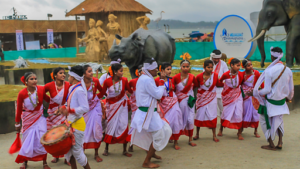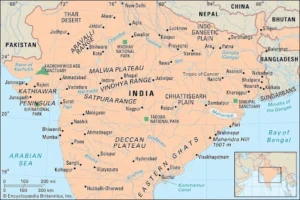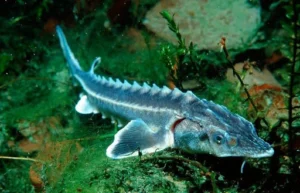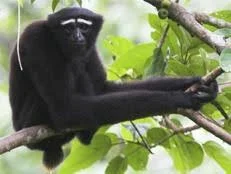UPSC GS 1
Jhumur Dance
- News: Guwahati to host grand ‘jhumur’ dance event with 8,000 tea tribe artists.
- Overview
-
- Community: Traditional dance of the tea tribe communities of Assam.
- Season: Typically performed during the Autumn season in Assam.
- Geographical Spread: Also found in a few parts of West Bengal.
-
- Performance Setting
-
- Location: Performed mostly in open areas like fields or under trees.
- Participants: Primarily young girls, accompanied by male members who maintain rhythm, provide vocals, and play musical instruments.
-
- Musical Accompaniment
-
- Main Instrument: The Madal, a popular two-headed hand drum.
- Additional Instruments: Flute and a pair of Taals, which enhance the harmony of the music.
-

- Dance Style
-
- Movement: Girls perform the dance holding each other’s waists, with synchronized movement of hands and legs forward and backward.
- Content: Incorporates songs and dialogues that reflect the joys, sorrows, yearnings, and aspirations of everyday life.
-
- Cultural Significance
-
- Ritual and Social Functions: Performed for various purposes including ritual worship, courting, lovemaking, and prayers for rainfall by the tea tribe communities.
- Historical Origin: Believed to have originally served as a means of recreation between phases of tedious agricultural work.
-
Mahanadi River Basin
- News: A state government official stated that there is no fear of flooding on the Mahanadi river system, despite water being released from the Hirakud Dam, which has raised the level at the Mundali barrage in Odisha’s Cuttack district.
- Overview
-
- Type: One of the major east-flowing peninsular rivers in India.
- Water Potential: Ranks second to the Godavari River among peninsular rivers in terms of water potential.
- Silt Deposition: Considered one of the most active silt-depositing rivers in India.
-
- Course
-
- Origin: The river originates from the Sihawa range of hills in the Dhamtari district of Chhattisgarh.
- Flow Direction: Flows in a southeastern direction through Chhattisgarh and Odisha.
- Length: Extends 860 km before emptying into the Bay of Bengal.
- Catchment Area: Extends over major parts of Chhattisgarh and Odisha, with smaller portions in Jharkhand, Maharashtra, and Madhya Pradesh.
- Major Cities: Passes through Raipur, Sambalpur, and Cuttack.
- Basin Area: Covers 141,589 sq.km, representing 4.3% of the total geographical area of India.
-

- Boundaries: The river is bounded in the north by Central India hills, in the south and east by the Eastern Ghats, and in the west by the Maikal hill range.
- Main Tributaries:
-
- Seonath River
- Jonk River
- Hasdeo River
- Mand River
- Ib River
- Ong River
- Telen River
- Hirakud Dam
-
- Description: The world’s longest earthen dam, spanning 26 km, constructed across the Mahanadi River about 15 km from Sambalpur in Odisha.
- Uses: Employed for irrigation, flood control, and power generation.
Read also: Kachchatheevu Island Dispute: Causes & Solutions | UPSC
UPSC GS 2
National Pharmaceutical Pricing Authority (NPPA)
- News: The National Pharmaceutical Pricing Authority (NPPA) has announced the fixing of retail prices of 54 drug formulations and eight special feature products.
- Establishment and Purpose
-
- Established: In 1997.
- Objective: To fix and revise the prices of controlled bulk drugs and formulations, and to enforce the prices and availability of medicines in the country.
- Regulatory Framework: Operates under the Drugs (Prices Control) Order, 1995.
-
- Role and Function
-
- Independent Regulator: Oversees drug pricing to ensure medicines are available and accessible at affordable prices.
-

- Administrative Structure
-
- Nodal Ministry: NPPA is an attached office of the Department of Pharmaceuticals (DoP), under the Ministry of Chemicals and Fertilizers.
-
- Key Functions
-
- Implementation and Enforcement: Enforces the provisions of the Drugs (Prices Control) Order according to delegated powers.
- Legal Matters: Addresses all legal issues arising from the Authority’s decisions.
- Monitoring Drug Availability: Monitors drug availability, identifies shortages, and takes remedial actions.
- Data Collection and Maintenance: Collects and maintains data on production, exports, imports, market share of individual companies, and profitability for bulk drugs and formulations.
- Research and Studies: Undertakes and sponsors relevant studies concerning drug pricing and pharmaceuticals.
- Parliamentary Assistance: Provides assistance to the Central Government on parliamentary matters related to drugs.
-
UPSC GS 3
Sturgeon
- News: Wildlife crime is threatening the survival of critically endangered sturgeon species, according to the latest WWF report on sturgeon poaching and trafficking in the Lower Danube region.
- Overview
-
- Sturgeon is the common name for the 28 species of fish belonging to the family Acipenseridae.
- These fish are known for their long lifespan and late maturation.
-
- Physical Characteristics
-
- Sturgeons are long-lived and late-maturing fish with distinctive features.
- They possess a heterocercal caudal fin, similar to those of sharks, and an elongated, spindle-like body that is smooth-skinned and scaleless.
- Their bodies are armored with five lateral rows of bony plates called scutes.
-
- Habitat and Distribution
-
- Sturgeon species are native to lower Danube countries such as Bulgaria, Romania, Serbia, and Ukraine, where they are known for producing caviar.
- The Danube is notable for being one of the last river bodies with functional populations of beluga (Huso huso), Russian (Acipenser gueldenstaedtii), stellate (Acipenser stellatus), and sterlet (Acipenser ruthenus) sturgeons.
-
- Caviar
-
- Caviar is a food consisting of salt-cured roe from the family Acipenseridae.
- Traditionally, the term caviar refers only to roe from wild sturgeon species in the Caspian Sea and Black Sea, including beluga, ossetra, and sevruga caviars.
-

- Conservation and Regulation
-
- In 1998, the Convention on International Trade in Endangered Species of Wild Fauna and Flora (CITES) listed sturgeon species as endangered and imposed restrictions on their fishing in the Danube and Black Sea.
- Since then, legal, internationally traceable caviar and meat can only be sourced from farmed sturgeons.
-
- Highlights of the Report
-
- Extinct Species: Of the six sturgeon species formerly native to the Danube River, two are considered locally extinct:
- European sturgeon (Acipenser sturio)
- Ship sturgeon (A. nudiventris)
- Remaining Species: The Lower Danube Basin is among the last European regions with self-reproducing sturgeon populations. All four remaining sturgeon species in the Danube Basin are listed as Threatened by the IUCN Red List.
- Stellate sturgeon (A. stellatus): Critically Endangered
- Russian sturgeon (A. gueldenstaedtii): Critically Endangered
- Beluga (Huso huso): Critically Endangered
- Sterlet (A. ruthenus): Endangered (raised to this category in 2022)
- Conservation Priority: The Lower Danube should be a priority for conservation efforts.
- Extinct Species: Of the six sturgeon species formerly native to the Danube River, two are considered locally extinct:
-
Parkinson’s Disease
- News: Researchers suggest that due to the higher-than-expected prevalence of gene mutations in Parkinson’s disease patients, genetic testing should be offered more broadly.
- Overview
-
- Definition: A progressive neurological disorder that affects the nervous system and body parts controlled by the nerves.
- Impact: Limits or eliminates control over movements and body balance.
- Age Factor: Risk naturally increases with age, with the average onset around 60 years.
- Gender Disparity: Studies suggest men are more likely to be affected than women.
-

- Cause
-
- Pathophysiology: Caused by the degeneration of nerve cells in the substantia nigra, a brain region that controls movement.
- Dopamine Deficiency: Damaged nerve cells lose the ability to produce dopamine, a chemical crucial for coordinating nerve and muscle cells involved in movement.
- Effect of Dopamine Loss: Leads to symptoms such as slowed movements and tremors.
-
- Symptoms
-
- Trembling in hands, arms, legs, and jaw, stiffness of limbs, slowness of movement etc
-
- Diagnosis
-
- Current Limitations: No blood laboratory or radiological tests available for diagnosing Parkinson’s disease.
-
- Treatment
-
- Cure: There is no cure for Parkinson’s disease.
- Management: Treatments aim to significantly improve symptoms and quality of life.
-
Tejas Light Combat Aircraft
- News: There is uncertainty about state-run plane maker Hindustan Aeronautics Limited’s (HAL) ability to meet the delivery timeline for the new Tejas light combat aircraft within the current financial year.

- Overview
-
- Type: 4.5-generation single-seat supersonic multirole fighter aircraft.
- Design and Development: Led by the Defence Research and Development Organisation’s (DRDO) Aeronautical Development Agency (ADA) under the light combat aircraft (LCA) programme, with Hindustan Aeronautics Limited (HAL) as the prime industrial contractor.
- Programme Inception: The LCA programme was envisioned in the late 1980s to replace the MiG-21 and Su-7 fleet.
- Service Entry: Entered service with the Indian Air Force (IAF) in July 2016.
- Indigenous Status: India’s second indigenous fighter jet after the HAL HF-24 Marut.
-
- Roles and Models
-
- Designated Roles: Offensive air support, close combat, and ground attack.
-
- Production Models:
-
- Tejas Mark 1
- Tejas Mark 1A
- Trainer variant
-
- Features
-
- Smallest and lightest in its class of contemporary supersonic combat aircraft.
- Weighs approximately 5,450 kg with a maximum take-off weight of 13,500 kg.
- Features a fin but lacks a horizontal tail.
- Powered by a single uprated General Electric F404-GE-IN20 engine.
- Designed to carry a range of air-to-air, air-to-surface, and precision-guided weapons.
-
Hoollongapar Gibbon Wildlife Sanctuary
- News: An approval by the Union environment ministry for exploratory oil and gas drilling in parts of Assam may put the Hoollongapar Gibbon Wildlife Sanctuary at further risk.
- Location and Status
-
- Location: An isolated protected area of evergreen forest in the Jorhat district of Assam, India.
- Status: Designated as a wildlife sanctuary in 1997 by the Assam Government.
- Significance: It is the only sanctuary in India named after a gibbon, due to its distinction of having the densest gibbon populations in Assam.
-
- Topography and River
-
- Altitude: Situated at an altitude between 100 and 120 meters (330 and 390 feet).
- Topography: Gently slopes downward from southeast to northwest.
- River: The Bhogdoi River creates a waterlogged region along the sanctuary’s border, dominated by semi-hydrophytic plants.
-

- Flora
-
- Upper Canopy: Dominated by the Hollong tree.
- Middle Canopy: Dominated by the Nahar tree.
- Lower Canopy: Consists of evergreen shrubs and herbs.
-
- Fauna
-
- India’s only gibbons: The hoolock gibbons.
- Northeastern India’s only nocturnal primate: The Bengal slow loris.It also has stump-tailed macaque, northern pig-tailed macaque, eastern Assamese macaque, rhesus macaque, and capped langur, Indian elephants, tigers, leopards, jungle cats, wild boar, three types of civet, four types of squirrel.
-

